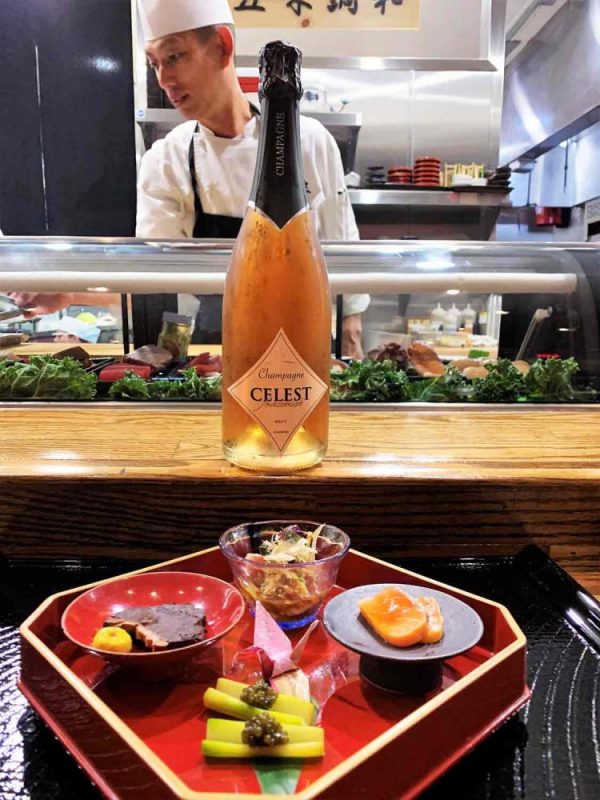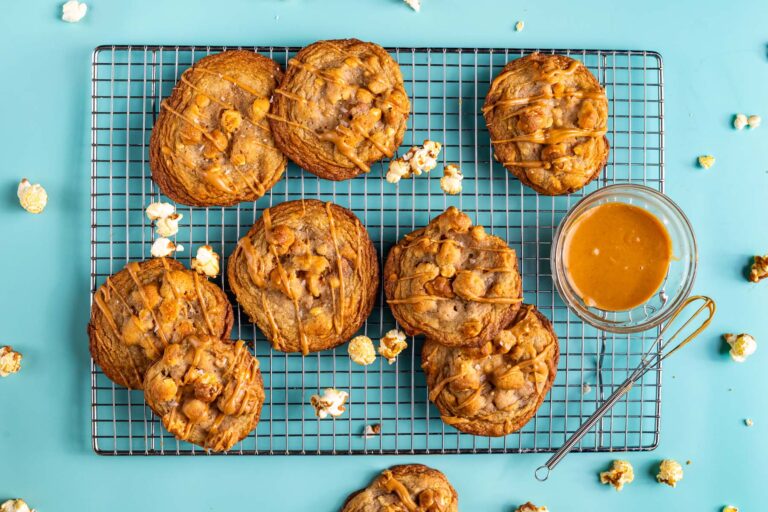Pairing Wine with Sushi

Sushi bars are the Chinese restaurants of twenty, thirty years ago. Japanese-inspired cuisine fulfills our craving for the exotic, but the food is more refreshing, light, simple yet just as sophisticated as, say, the cuisines of China.
So what should a wine lover drink with sushi?
Green tea, with its mildly earthy, umami laced taste, is Japan’s a priori match for sushi. But what else? In Japan, beer and sushi has become just as much of a natural; the combination of frothy, mildly bitter drafts and those wasabi-tinged pillows of pleasure can attack you like a naughty dream in the middle of the night.
Over the years we have taken to drinking Champagne or other dry sparkling wines with sushi. The combination may not be common or traditional, but it makes a lot of sense. Like beer, sparkling wines are cold and tactilely stimulating, and their steely, yeasty notes energize the mildly sweet, winey, rice-vinegar tastes of sushi rice. It may seem decadent to drink a $150 bottle of creamy, yeast-infused Dom Pérignon with your hamachi, maguro (tuna) or Hawaiian rolls, but what a way to go.
But, of course, for everyday drinking, sparkling wines may not be as practical or desirable as regular tables wines; especially if it normally takes you a few days to go through a bottle. So over the years we have done our due diligence by researching a full range of supermarket variety table wines with sushi — always with the levity of the taste of sushi itself — and have been amazed by the number of surprising matches. Contrary to what you might think, not all varieties of sushi are alike when it comes to wine. In fact, some combinations seem diametrically opposed.
1. WHAT WINE TO SERVE WITH MAGURO (BIGEYE TUNA)
Best Match: Soft, complex reds (American Pinot Noir)
2nd Choice: Soft, dry whites (California Chardonnay, Australian “unwooded” Chardonnay, or American or Alsatian Pinot Blanc
Maguro sushi rarely fails to epitomize the concept of red-wine-with-fish; and perhaps it is because of the fish, which when tasted raw is more like red meat: clean, fresh and oily rich, yet devoid of any sense of “fishiness.” When you dip maguro sushi into soy sauce mixed with wasabi (the spicy green horseradish), the versatile food range of soft, low tannin, zesty and complex red wines like Pinot Noir really comes into play. Round, tender qualities of the grape seem to mirror the lush oiliness of the fish, and the bright, fragrant, peppermint-spiced flavors easily tame the taste of wasabi and even mingle with the exotic tingling of pickled ginger.
But if you prefer white wine, you’d be just as surprised by how effortlessly a typical New World-grown Chardonnay’s round, buttery texture fits into the picture. Logic may tell you that oily fish should taste better with lighter dry whites (like Sauvignon or Fumé Blanc) with a lemony crisp edge of acidity. Yet the taste of fatty tuna is more easily broadened and enriched by fattier, smoother, glycerol-textured Chardonnays. The only caveat would be to try to choose a mildly oaked brand of California Chardonnay (common enough on American supermarkets’ lower priced shelves); or perhaps even better, one of the “unwooded” styles of Chardonnay from Australia (a specialty retailer might be able to point out one or two).
Finally, it is also worth trying the smooth and finely textured style of dry white called Pinot Blanc, produced in both the U.S. and in Alsace, France, and which many aficionados think of as a lighter alternative to Chardonnay. In fact, Pinot Blanc’s rich, rounded qualities, without excessive alcohol, make a dependably seamless match with the rich, fatty-textured taste of maguro, whether served as sushi or sashimi. Definitely an experience!
2. PAIRING HAMACHI (YELLOWTAIL) AND SHIRO MAGURO (ALBACORE) AND WINE
Best Match: Soft, dry whites (American or Australian Chardonnay, or
American or Alsatian Pinot Blanc)
2nd choice: Softly dry, light white (Australian Semillon-Chardonnay)
Although hamachi is the richer, creamier (in its whiter color as well as texture), more sensually textured of these two types of sushi fish, neither one is as rich in fats as the classic red tunas (maguro or toro). Therefore, think of both yellowtail and albacore in the same terms in respect to their ideal wine match: moderately full, fat, creamy-textured American or Australian Chardonnay, or the lighter but equally rich, viscous Pinot Blanc.
Soft, mildly meaty albacore (sometimes called “white tuna,” although its color is more of a pale, peachy red) likes a moderately scaled, soft dry white; and so for this particular sushi, you’ll probably have the most success with Australian blends of Semillon and Chardonnay — the Semillon grape giving just as round and fleshy a taste as Chardonnay, but discernibly lighter in weight, while contributing a unique, figgy scent and flavor of its own (the Rosemount Semillon-Chardonnay is a commonly seen brand).
3. BEST WINE TO SERVE WITH SAKE (SALMON)
Best Match: Dry Riesling (preferably German)
2nd Choice: Soft, earthy/fruity reds (American Pinot Noir, or red Burgundy or Beaujolais from France)
Salmon for sushi does not come to you raw; but is first smoked and cured in salt and sugar for a few days; the subtle balance resulting from this process adding up to an aggressive flurry of smoky, sweet, salty sensations, the oily taste of the salmon itself practically melting in the mouth.
For this one-two punch, choose a light tannin, smoky/spicy style of Pinot Noir-based red wine from Burgundy in France (like Volnay, Santenay, or regional Côtes de Beaune or Bourgogne); although less earthier California and Oregon Pinot Noirs can serve a similar purpose, as would the even softer, fruitier red wines made from the Gamay grape (Beaujolais Villages, Beaujolais Nouveau, or one of the more feminine grand crus of Beaujolais such as Fleurie and Chiroubles).
However, it must be said that the wines that bring salmon sushi into the sharpest focus are probably the dry (trocken style) or off-dry (halbtrocken) Rieslings of Germany, which carry a mouthwatering acidity like no other, without the excess of sweetness that would distract the palate from appreciating the balanced taste of the sushi itself.
4. WHAT WINE TO SERVE WITH IKURA (SALMON ROE) OR TOBIKO (FLYING FISH ROE)
Best match: Dry Rosé (pink Grenache from France, Australia or California)
2nd choice: Dry Riesling (France, Germany or New Zealand)
When it comes to the explosive, sea-salty taste of these reddish-orange varieties of caviar (tobiko eggs are the tinier of the two), you would again expect to find a contrasting match in some kind of slightly sweet white wine. But white wines with perceptible sweetness always seem to take something away from the taste of ikura and tobiko. So the wines to gravitate toward are the dry pink wines made from the Grenache grape.
Dry pinks, which are vinified from red grapes (but without the dark color or drying tannin), can contribute a broad, fleshy feel and mouthwatering sense of fruitiness – just the thing to wash down these delightful little poppers (especially when colored and flavored with spicy wasabi). There are a number of excellent Grenache rosé producers in California, but the finest examples come from France (the Rhone Valley’s Tavel Rosé, or Bandol Rosé from Provence), and perhaps even from Australia (Charles Melton’s brilliantly intense and flavorful Rosé of Virginia)
Our second best match for ikura and tobiko would be neither a fruity red (red wines like Pinot Noir taste tinny with fish eggs) nor a sweet white, but, rather, a bone-dry style of Riesling — particularly those of Alsace in France, Germany (must be labeled as trocken or “dry”) and New Zealand — which has the advantage of retaining a fruity flavor without residual sugars, and bracing enough acidity to freshen the palate between bites of sushi roe and whatever else may follow.
5. BEST WINE TO PAIR WITH UNAGI (FRESHWATER EEL) AND ANAGO (MARINE EEL)
Best match: Dry Riesling (preferably German)
2nd choice: Dry Rosé or Vin Gris of Pinot Noir (California or France)
Like salmon, eel for sushi is always cooked; both varieties dipped in a teriyaki style sauce and hibachi grilled. Thus, their smoky, fatty, sweetly glazed flavors present a challenge for wine. Balance out unagi and anago’s sweet/salty/oily edges with one of the rare, zesty pink Champagnes of France (Iron Horse in Sonoma also makes a world class pink sparkling wine). But if you don’t want to go that somewhat pricey route, dry pink table wines made from the Pinot Noir grape — such as the occasional vin gris bottlings from California, or the fragrant, finessed rosés of France’s Marsannay or Sancerre regions — all have a way of lightening the taste of grilled eel on the palate.
Of course, whether sparkling or non-sparkling, good, dry pink wines vinified from Pinot Noir do not exactly grow on trees; and so you may find the second choice to be a little more practical: either a trocken (“dry”) or halbtrocken (“half-dry”) Riesling from Germany, both of which have the acidity to balance out the extremes of eel’s taste sensations, without adding significant enough residual sugar to make the combination cloying.
6. PAIRING UNI (SEA URCHIN) WITH WINE
Best match: Steely dry, minerally whites (Savennieres or Pinot Gris from
France, or German Pinot Gris)
2nd choice: Flinty dry, crisp Albarino (Spain)
The strong, earthy, faintly gamy or offal-like taste of sea urchin ovaries is an instinctive one (you either love it or hate it) to say the least, and so the search for its best wine match has long been a solitary one. Beaujolais and Pinot Noirs bring a nice mingling of umami sensations to the table, but the mild tannins of red wine don’t actually improve the taste of uni itself. Demi-sec (half-dry) Vouvray has popped into some uni lovers’ gastronomic radar, but the pronounced earthiness of uni does not do anything for this pretty, flowery-scented white wine (vinified from Chenin Blanc) from France.
Try, instead, a steely dry, fairly acidic white with distinctively minerally or earthy undercurrents — it seems to be the latter two qualities that accomplish the task of scrubbing and brightening the sea/earthy taste of uni on the palate, without discernible loss of vinous qualities in the exchange. Our top choices in order of preference: Savennieres (ringingly dry, unfruity, earth-toned Chenin Blanc-style white from France’s Loire River), German or French grown Pinot Gris (American and Italian versions of this grape lack the bracing minerality), and Spain’s Albariño (its crisper, flintier variations). Granted, these are not commonly found wines; then again, uni is an uncommon taste.
7. WHAT WINE TO SERVE WITH NORI (SEAWEED) HAND ROLLS
Best match: Soft, fruity reds (Pinot Noir or Beaujolais)
2nd choice: Dry, fruity Sauvignon Blanc (California or New Zealand)
There are endless variations of hand rolls made in sushi bars — from shichimi-spiked “spicy tuna” mixes to unagi, sake, salmon skin, ikura, shrimp tempura, kani (crab), and even soft shell crab, plus the usual bouquets of crispy cucumber, spice sprouts, shiso and avocado — but this all lumps into one category because of its common ingredients: the somewhat smoky, crispy, “ocean” taste of the nori wrap (pressed and toasted seaweed), and the lethal taste of wasabi that sushi chefs like to sneak under the nori (you get hurt if you are not careful to taste before dipping your hand roll into an extra dose of wasabi in shoyu).
The most versatile choice for hand rolls is any one of the softer, fruitier red wines — especially Pinot Noir or French Beaujolais — which invariably makes an easy flavor connection with the earthy/toasty taste of nori as well as wasabi, especially if there is also a sprinkling of toasted black sesame seeds in the roll.
But fruitier styles of dry Sauvignon (or “Fumé”) Blanc from California and New Zealand also work with varieties of hand roll, the wines’ sweet melony fruitiness proving a refreshing contrast with the hot taste of wasabi, as well as with the palate-rattling chile spices, oils and even pastes so often used (thus to be expected) in contemporary hand rolls. The lightly green-herbal underpinnings of typical Sauvignon Blancs also merge neatly with many of the vegetables, herbs, special sauces, and fruits (e.g., fresh asparagus, scallions, cress and mint leaves, daikon, spicy “dynamite” mayonnaises, and even papaya and mango) that are now commonly used.
Sushi is more fun than ever, and certainly no longer predictable. Why not take the same approach with your choice of wine?




